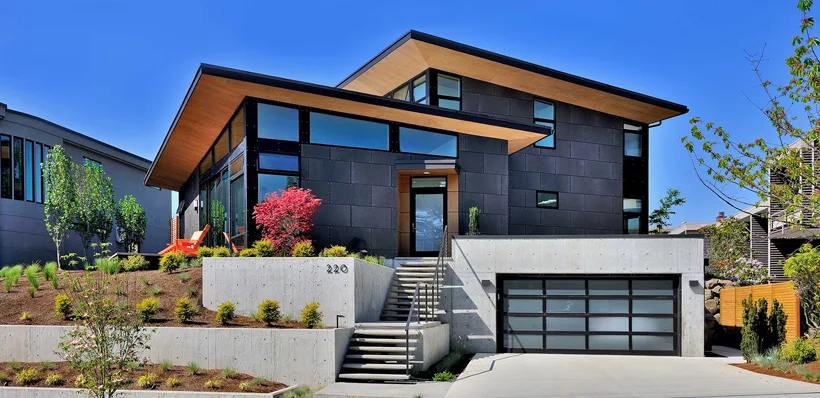Mid-century Modern Architectural Style: Embracing the Timelessness
Defining the Midcentury-Modern Architectural Style
If you've at any point flipped through home plan magazines or watched a couple of episodes of "Mad Men", chances are you've run over the expression "midcentury-modern" at some point. Yet, what precisely is this architectural style that has acquired such a lot of popularity as of late? Furthermore, who are the pioneers behind its iconic designs?In the vast landscape of architectural design, one style stands out as a beacon of innovation and timelessness – the Midcentury-Modern. Emerging in the mid-20th century, this architectural movement has left an indelible mark on the design world, blending functionality with aesthetics.
 |
| Midcentury modern architecture is an American classic that emerged after World War II. Photo: shoesmithcox.com |
In this blog post, we will delve into the roots and evolution of Midcentury-Modern architecture, exploring its defining characteristics, highlighting some iconic live examples, and the architects who pioneered this captivating style. We will reveal, as well, why it continues to be loved by homeowners and design enthusiasts alike. So let’s get started and uncover the secrets of this timeless style!
Origins and History at a Glance
The Midcentury-Modern architectural style prospered between the 1940s and 1960s, acquiring prominence as a response to the evolving socio-economic scene after World War II. It was a takeoff from the luxurious and elaborate plans of the past, expecting to make an amicable connection between people and their living spaces.
The movement found its roots in the Bauhaus principles, emphasizing functionality, simplicity, and seamless integration with nature.
Main Key Characteristics
- Clean Lines and Functional Forms: At the core of Midcentury-Modern design is a commitment to simplicity. Clean lines and functional forms define the architecture, eliminating unnecessary ornamentation. This minimalist approach contributes to an open and uncluttered feel in both interior and exterior spaces.
- Integration with Nature: Midcentury-Modern designers looked to bring the outdoors in, obscuring the boundaries between the interior and exterior. Large windows, sliding glass doors, and open floor plans create a sense of connection with nature, allowing natural light to flood the living spaces. Want to know more about how to integrate nature with indoor design? Read this article about Biophilic Design: Embracing Nature in the Indoor Built Space.
- Use of Innovative Materials: The architects of this era embraced new materials and technologies. Steel, glass, and concrete were popular choices, allowing for a more open and flexible design. These materials not only added a touch of modernity but also contributed to the durability and longevity of the structures.
- Flat or Low-Pitched Roofs: The roofs in Midcentury-Modern homes are often flat or have a low pitch, emphasizing the horizontal lines of the design. This feature not only enhances the overall aesthetic but also facilitates a closer connection to the surrounding environment.
- Open Floor Plans: The concept of open living spaces became a hallmark of Midcentury-Modern design. Removing unnecessary walls and partitions, architects aimed to create fluid, adaptable spaces that suited the evolving lifestyle of the post-war era. Read more »
Pioneering Architects and Iconic Examples:
Frank Lloyd Wright:
While not exclusively a Midcentury-Modern architect, Frank Lloyd Wright's influence on the movement is undeniable. His Fallingwater, completed in 1939, is an early example of integrating modern design with nature. The house, dramatically suspended over a waterfall, exemplifies the principles that would later define Midcentury-Modern architecture.
 |
| Dorland House, Photo from Pinterest. |
The "Dorland House", shown in the image above, is another creation of Frank Lloyd Wright. Also known as the Ernest E. Jorgensen Residence, it was indeed designed by Wright in 1950. It is located in Los Angeles, California, and is considered one of Wright's notable works from his later years. The house features its signature organic architecture principles, with its horizontal lines, integration with nature, and emphasis on functionality and simplicity.
Richard Neutra:
A key figure in the development of the Midcentury-Modern style, Richard Neutra's designs focus on simplicity and a strong connection to the outdoors. The Kaufmann House, designed by Neutra in 1946, is a prime example, with its flat roof, expansive glass walls, and emphasis on horizontal lines. (See image below)
 |
| The Kaufmann House is a prime example, with its flat roof, expansive glass walls, and emphasis on horizontal lines. Photo: sarahakwisombe.com |
Charles and Ray Eames:
Renowned for their contributions to furniture design as well, the Eames duo made a significant impact on Midcentury-Modern architecture. The Eames House in Los Angeles, constructed in 1949, showcases their innovative use of materials, including steel and glass, and their commitment to open, adaptable spaces.
 |
| Eames House in Los Angeles, a creation of the Eames duo, showcases the innovative use of steel and glass. Photo: Reddit |
Mies van der Rohe:
While his work predates the official Midcentury-Modern era, Mies van der Rohe's principles align closely with the movement. The "Farnsworth House", completed in 1951, exemplifies his dedication to simplicity, transparency, and the integration of architecture with its natural surroundings.
It is good to note that those are just a few of the pioneers and their works that used the Midcentury-Modern style to showcase their concepts. To know more about this captivating style and others, please follow my blog for more interesting architectural topics.
In the end, Midcentury-Modern architecture remains an immortal and compelling movement, proceeding to inspire architects and property holders the same. Its emphasis on simplicity, functionality, and a seamless connection with nature rises above fleeting limits, making it a style that has persevered, developed, and evolved over decades in the long term.
As we glance back at the pioneers of this movement and their iconic creations, we gain a more profound appreciation for the persevering tradition of Midcentury-Modern architecture in molding how we live and encounter our constructed surroundings.
.png)






